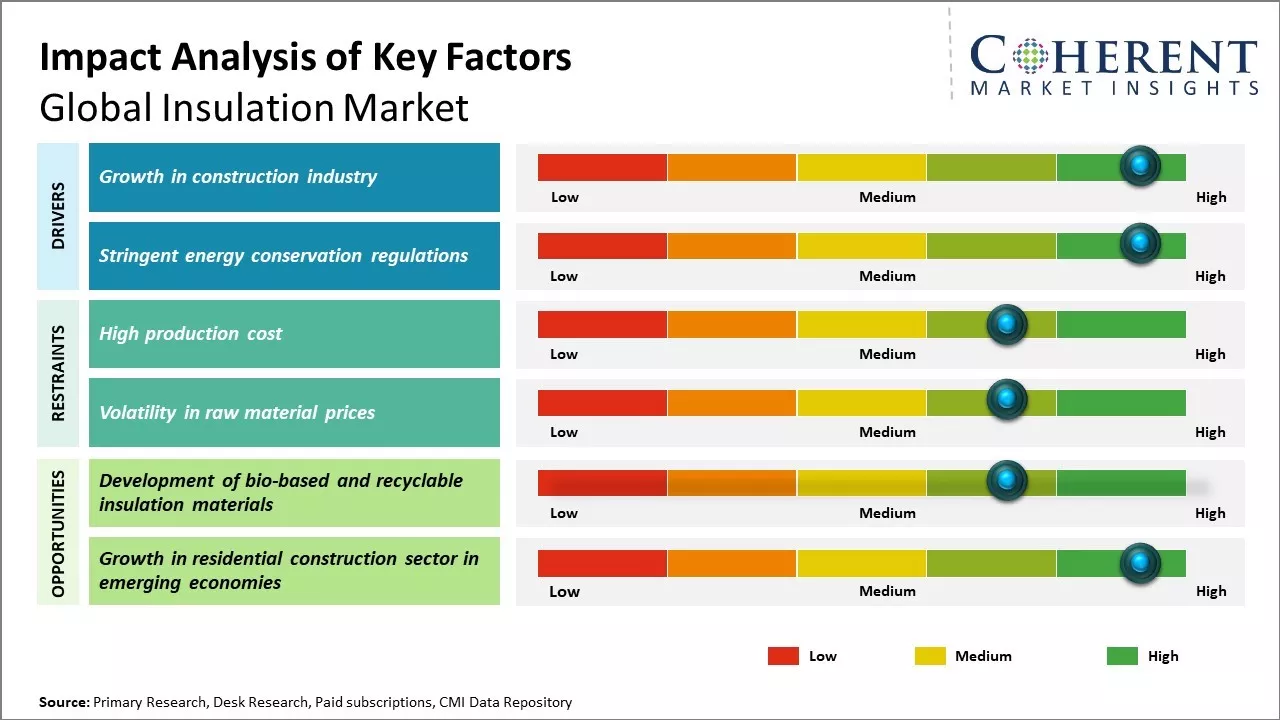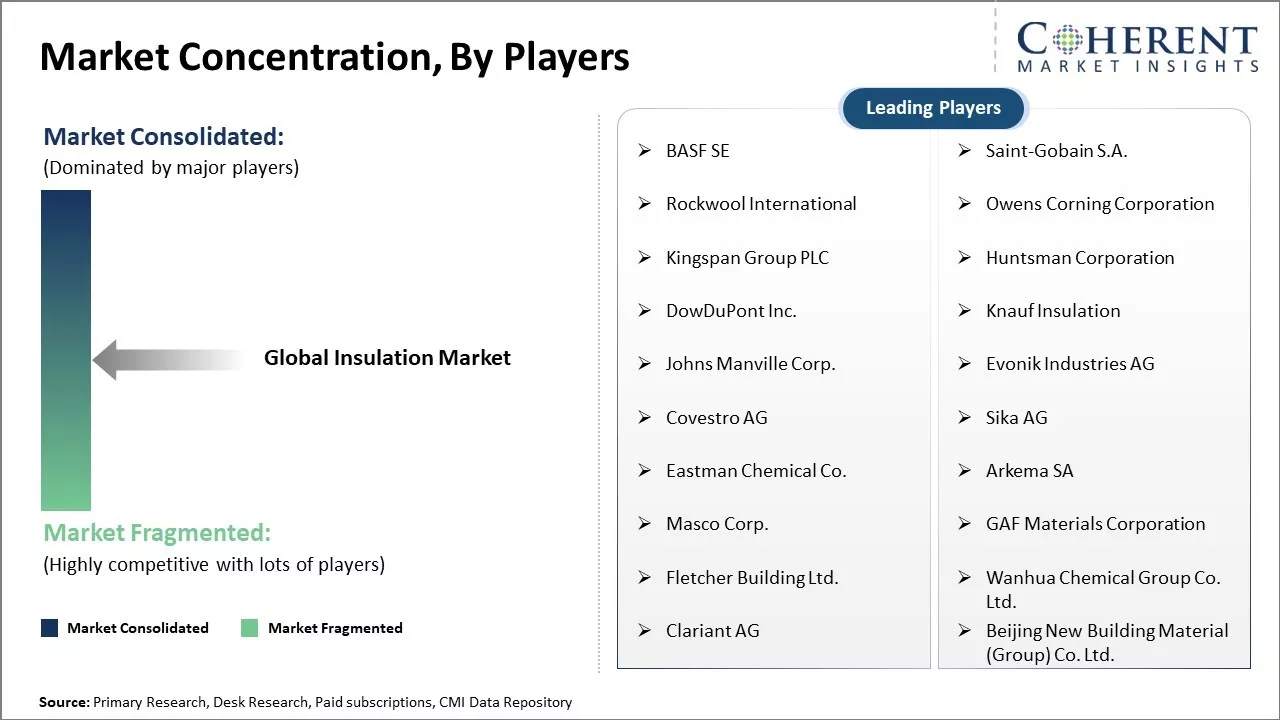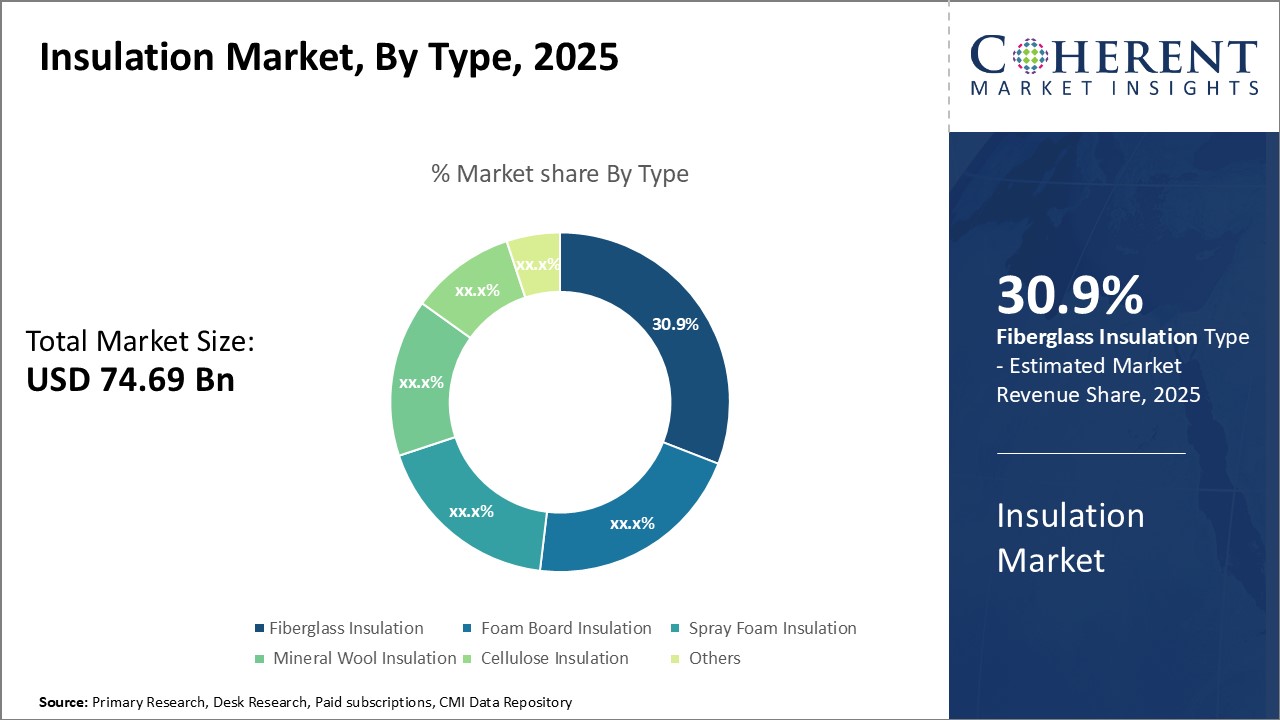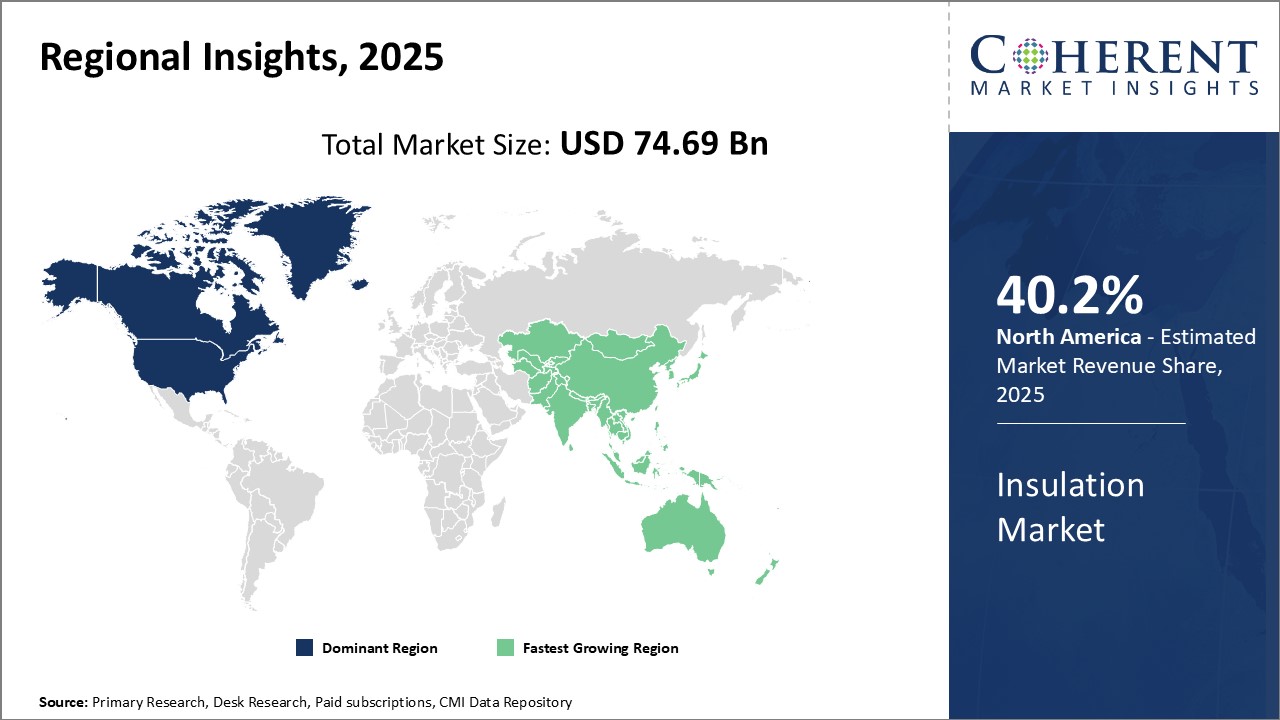Insulation Market Size and Trends
Global insulation market is estimated to be valued at USD 74.69 Bn in 2025 and is expected to reach USD 119.23 Bn by 2032, exhibiting a compound annual growth rate (CAGR) of 6.9% from 2025 to 2032.

Discover market dynamics shaping the industry: Download Free Sample
Global insulation market is expected to witness significant growth during the forecast period owing to increased construction activities and rising demand for thermal and sound insulation from various end-use industries like building & construction, automotive, and industrial. The global insulation market shows growing preference for bio-based and green insulation materials across the world. With rising awareness about environment protection, manufacturers are developing more sustainable and eco-friendly insulation solutions made from renewable and naturally occurring resources. Growing remodeling and renovation activities of residential and commercial buildings are also driving the demand for advanced fiberglass and foam insulation products.
Growth in construction industry
The global construction industry has seen rapid expansion over the past few years and going forward as well, various factors are contributing to this steady rise. According to data by Invest India released in 2022, the construction industry in India is expected to reach US$ 1.4 Tn by 2025. Worldwide, urbanization is gaining pace as people are migrating to cities at an increasing rate which is driving the need for new residential and commercial construction. Governments across major economies have also recognized the impact of construction on job creation and economic growth, hence large investments are being made in building new infrastructure projects. In countries like China and India massive housing shortages exist which the governments are trying to address through various policies and mission programs to develop affordable housing.
New technologies are also enabling more complex and innovative building designs to come up which require advanced insulation materials. With growing environmental consciousness, sustainability aspects are gaining higher emphasis in construction where proper insulation helps reduce energy costs as well as the carbon footprint of buildings. Rapid industrialization and manufacturing activities particularly in Asia Pacific is necessitating new factory buildings, warehouses, and other commercial spaces to come up. Meanwhile rising incomes have boosted consumer demand for luxurious and larger homes fitted with modern amenities. The hospitality sector too has witnessed strong growth supported by global tourism, resulting in new hotel constructions.
All of the above macro factors such as increasing population, urbanization, infrastructure push, housing programs, and industrial growth collectively indicate a steady expansion in building & construction activities worldwide. This acts as a key driver propelling the demand for various insulation materials which are essential in walls, roofs, and pipes to regulate indoor temperature and maximize energy efficiency of structures. A booming construction industry thus ensures a conducive environment for insulation products to witness growing consumption over the next decade.
Market Concentration and Competitive Landscape

Get actionable strategies to beat competition: Download Free Sample
Stringent Energy Conservation Regulations
With climate change emerging as a grave threat, many countries globally have introduced stringent regulations mandating higher energy efficiency standards for new buildings. These norms aim to reduce carbon emissions as well as dependence on fossil fuels by curbing wasteful usage of power for space heating/cooling. Proper insulation plays a critical role in meeting the targeted efficiency levels. Both government and commercial buildings are now required to obtain certain certifications demonstrating optimal insulation levels to qualify for permits and incentives.
Specific insulation R-values are mandated for walls, attics which can only be achieved through the deployment of premium products. Even residential properties see stiffer codes being put in place to nudge homeowners into retrofitting their homes for better insulation. Non-compliance may attract penalties. Moreover, various incentive schemes and tax rebates are offered to encourage insulation upgrades. Rising environmental awareness among public has also boosted voluntary adoption of green materials and solutions.
Stringent building energy codes not only impact the quantity of insulation installed but also product quality requirements. Specialized materials with enhanced ratings are emerging to satisfy regulations. Insulation providers have upscaled R&D spending to innovate products integrating latest innovations and deliver on-site verification of prescribed insulation levels. With decarbonization commitments becoming more widespread and ambitious, the push for upgraded insulation standards across regions is likely to intensify over the coming years.
Key Takeaways from Analyst:
The global insulation market is experiencing steady growth driven by increasing construction activities across both commercial and residential sectors globally. The rapid urbanization and industrialization in developing countries of Asia Pacific and Latin America is a key growth driver as these regions witness high demand for insulating materials in infrastructure and building construction.
Another major driver is the rising need for thermal and acoustic insulation in various end-use industries like automotive, industrial, and appliances. Strict government regulations regarding energy efficiency in buildings provide a fillip to insulation installation. However, volatility in raw material prices remains a restraint to the consistent growth of the market.
The market is quite fragmented with the presence of numerous international and regional players. From a regional perspective, North America dominates the global insulation market and is expected to witness the fastest gains over the forecast period. This is attributable to growing construction activities, rising disposable incomes, and expanding middle-class populations in region.
North America is a sizable market and is likely to exhibit steady demand growth supported by the renovation of old infrastructure and strong emphasis on energy conservation in the U.S. and Canada. Stringent insulation standards for new constructions in Europe will propel the regional market. Latent opportunities lie in thermal and Heating, Ventilation, and Air Conditioning (HVAC) insulation for the fast-growing renewable sector along with superior insulation materials with enhanced performance properties.
Market Challenge - High production cost
One of the key challenges faced by the global insulation market is the high production costs associated with insulation materials. The raw materials required for most common insulation materials like fiberglass, mineral wool, polystyrene etc. are energy intensive to produce and process. Extracting resources, heating them to high temperatures during manufacturing and then processing them into insulation board or rolls requires significant electricity and fuel costs. With rising energy prices worldwide, the raw material costs have been increasing steadily over the past decade. Additionally, the machinery and plant required for mixing, cutting, rolling etc. also involve large capital investments. Maintaining quality control during manufacturing and meeting stringent fire resistance, moisture resistance and thermal performance standards also increases operational expenses. The increased costs are often passed on to consumers in the form of higher insulation prices. This poses affordability issues especially in developing markets and affects the growth potential of the industry.
Market Opportunity - Development of bio-based and recyclable insulation materials
One of the major opportunities for the global insulation market is the development of more sustainable and eco-friendly insulation materials, for instance, In April 2024, SA-Dynamics announced a significant advancement in sustainable materials with the development of bio-based and recyclable insulation textiles made from 100% bio-based aerogel fibers. This innovative product represents a major step forward in the quest for eco-friendly insulation solutions, combining high performance with environmental responsibility. With growing environmental consciousness, researchers and manufacturers have been investing in technologies to produce insulation using bio-based or recyclable raw materials. Such materials help address sustainability and waste management issues. For example, various types of insulation such as bio-based and other are now being developed from agricultural waste fibers like hemp, sheep wool and cotton. These natural fibers have excellent thermal insulation properties and help reduce reliance on petroleum-based polymers. Similarly, efforts are underway to effectively reuse and recycle commonly used insulation materials like fiberglass and polystyrene scrap in new production cycles. This helps lower costs as well as the environmental impact of the industry over the long term. The advancement of bio-based and circular insulation economy aligns well with global priorities and regulatory tailwinds, thus presenting lucrative opportunities for market stakeholders.
Insights by type: versatility and cost-effectiveness

Discover high revenue pocket segments and roadmap to it: Download Free Sample
In terms of type, fiberglass insulation is expected to contribute 30.9% share of the market. Fiberglass insulation dominates the global insulation market due to several key advantages it offers over other insulation materials. Fiberglass is made from abundance glass fibers arranged in a random pattern, giving it high versatility in application. The random fiber structure allows it to be easily formed into batts, rolls, loose-fill, and board dimensions to insulate any building cavity or surface. This makes fiberglass compatible for use in walls, attics, floors, ductwork, and others.
Its versatility stems from fiberglass being a non-combustible material that is moisture and mold resistant. Fiberglass insulation performs well even under humid or wet conditions unlike certain organic insulations. It will not deteriorate over time from moisture exposure. This durability reduces life-cycle costs for builders and homeowners. Fiberglass is also odorless and breathable, trapping air for effective insulation without restricting airflow.
In terms of price, fiberglass insulation is one of the most cost-effective options available. The raw materials are abundant and the manufacturing process is well-established. This allows fiberglass to be produced at scale for widespread use around the world. In many regions, fiberglass insulation carries the lowest initial material cost compared to other types. Maintenance costs are also low since fiberglass has lasting insulating properties and does not require replacement over the lifetime of a building.
Insights by application: Growing energy efficiency needs in residential and non-residential buildings
Building & construction is expected to contribute the 36.1% share of the global insulation market in 2025, accounting for 37.2% share in 2024. The building and construction segment holds the largest share of the global insulation market. This is driven by an increasing focus on thermal efficiency in both residential and commercial construction activities worldwide. Thermal insulation helps improve energy efficiency by reducing heating and cooling loads in buildings. This directly cuts operational expenses related to HVAC systems and lighting. Tighter building codes globally now mandate minimum insulation levels to achieve higher thermal performance standards in new constructions. Retrofitting insulation in existing building stock is also pushing growth in this end-use industry. Residential construction, including single family homes and multi-family units, sees widespread adoption of insulation to meet residential energy efficiency codes. Homeowners are also more conscious of insulation benefits like improved indoor comfort levels and reduced utility bills. Non-residential buildings ranging from offices to warehouses require insulation for both new builds and renovations to conform to stricter commercial energy standards. Public infrastructure like schools and hospitals to contribute to insulation product demand.
Regional Insights

Need a Different Region or Segment? Download Free Sample
North America has established itself as the dominant region in the global insulation market. The region is expected to hold 40.2% of the market share in 2025, due to the large construction industry and established manufacturing sector present in the U.S. and Canada. Several industry-leading players such as Owens Corning Corporation and other have their headquarters and manufacturing plants located in the region, allowing them easy access to raw materials and the ability to cater to the domestic demand.
Construction activities in the commercial and industrial segments continue to drive the use of insulation in North America. Strict building codes regarding energy efficiency further boost the adoption of insulation products. There is a rising preference for sustainable insulation materials such as glass wool and stone wool over conventional petrochemical-derived insulations. The presence of advanced infrastructure also provides North American manufacturers an edge in exports over other regional players.
Among the fastest growing regional markets for insulation is Asia Pacific. Rapid urbanization and infrastructure development across China, India, Indonesia, and other developing nations have been the key growth drivers. The residential construction sector, in particular, has seen double-digit expansion rates annually. With rising incomes and improving standards of living, insulation is gradually becoming an integral part of construction projects rather than an optional add-on.
Rising exports of machinery, electronics and manufactured goods have augmented investments in large industrial and commercial facilities as well. This commercial development has significantly contributed to insulation demand from the Asia Pacific region. Another advantage for the region is the abundant availability of low-cost raw materials and workforce. This allows insulation producers to maintain competitive price points – attracting greater consumption as well as helping promote their brands in international markets.
Major players from North America and Europe are increasingly setting up joint ventures and greenfield facilities in the Asia Pacific region to capitalize on its high growth potential. Several developing nations like China also offer government subsidies and tax incentives to encourage investments in energy-efficient infrastructure and green building projects. These supportive initiatives have made Asia Pacific one of the most opportune regional markets for insulation and one that will likely rival North America in the coming years.
Market Report Scope
Insulation Market Report Coverage
| Report Coverage | Details | ||
|---|---|---|---|
| Base Year: | 2024 | Market Size in 2025: | USD 74.69 Bn |
| Historical Data for: | 2020 To 2024 | Forecast Period: | 2025 To 2032 |
| Forecast Period 2025 to 2032 CAGR: | 6.9% | 2032 Value Projection: | USD 119.23 Bn |
| Geographies covered: |
|
||
| Segments covered: |
|
||
| Companies covered: |
BASF SE, Saint-Gobain S.A., Rockwool International, Owens Corning Corporation, Kingspan Group PLC, Huntsman Corporation, DowDuPont Inc., Knauf Insulation, Johns Manville Corp., Evonik Industries AG, Covestro AG, Sika AG, Eastman Chemical Co., Arkema SA, Masco Corp., GAF Materials Corporation, Fletcher Building Ltd., Wanhua Chemical Group Co. Ltd., Clariant AG, and Beijing New Building Material (Group) Co. Ltd. |
||
| Growth Drivers: |
|
||
| Restraints & Challenges: |
|
||
Uncover macros and micros vetted on 75+ parameters: Get instant access to report
Insulation Industry News
- In May 2024, Mannok, a leading manufacturer of building materials, launched the newest addition to its extensive insulation range. This latest innovation is designed to meet the growing demand for high-performance, energy-efficient insulation solutions in the construction industry. The new insulation product boasts enhanced thermal properties, ensuring superior heat retention and reduced energy consumption in buildings. Additionally, it incorporates sustainable materials and manufacturing processes, aligning with Mannok's commitment to environmental responsibility. With its advanced features and commitment to innovation, this new insulation solution from Mannok is poised to become a game-changer in the market, helping to drive the transition towards more sustainable and energy-efficient building practices.
- In May 2024, Knauf Insulation, Inc., a renowned family-owned global manufacturer of fiberglass insulation, announced the launch of its innovative HVAC fiberglass insulation product line, Knauf Performance+. This groundbreaking product line is notable for being the first of its kind to be certified asthma & allergy friendly, making it an ideal choice for improving indoor air quality in residential and commercial spaces.
- In 2023, ALP Aeroflex, a leading manufacturer of insulation products, introduced a new range of insulation solutions specifically designed for high-speed rail coaches in India. This innovative product line, developed and manufactured locally, aims to meet the unique requirements of the country's rapidly expanding high-speed rail network.
- In 2020, Owens Corning, a global leader in insulation, roofing, and fiberglass composite materials, introduced its next-generation fiberglass insulation products. This innovative line of insulation is designed to enhance energy efficiency, improve indoor air quality, and provide superior thermal performance for residential and commercial buildings.
*Definition: The global insulation market includes companies involved in manufacturing and selling materials that provide thermal, acoustic and electrical insulation. These materials reduce heat transfer, sound transmission, and electrical shorting. The market comprises materials like stone wool, fiberglass, foam plastic which are used in construction, industrial, HVAC, and Original Equipment Manufacturer (OEM) applications in buildings, refrigeration and pipe systems.
Market Segmentation
- By Type Insights (Revenue, USD Bn, 2020 - 2032)
-
- Fiberglass Insulation
- Foam Board Insulation
- Spray Foam Insulation
- Mineral Wool Insulation
- Cellulose Insulation
- Others
- By Application Insights (Revenue, USD Bn, 2020 - 2032)
-
- Building & Construction
- Industrial
- HVAC Systems
- Transportation
- Others
- Regional Insights (Revenue, USD Bn, 2020 - 2032)
- North America
- U.S.
- Canada
- Latin America
- Brazil
- Argentina
- Mexico
- Rest of Latin America
- Europe
- Germany
- U.K.
- Spain
- France
- Italy
- Russia
- Rest of Europe
- Asia Pacific
- China
- India
- Japan
- Australia
- South Korea
- ASEAN
- Rest of Asia Pacific
- Middle East
- GCC Countries
- Israel
- Rest of Middle East
- Africa
- South Africa
- North Africa
- Central Africa
- North America
- Key Players Insights
-
- BASF SE
- Saint-Gobain S.A.
- Rockwool International
- Owens Corning Corporation
- Kingspan Group PLC
- Huntsman Corporation
- DowDuPont Inc.
- Knauf Insulation
- Johns Manville Corp.
- Evonik Industries AG
- Covestro AG
- Sika AG
- Eastman Chemical Co.
- Arkema SA
- Masco Corp.
- GAF Materials Corporation
- Fletcher Building Ltd.
- Wanhua Chemical Group Co. Ltd.
- Clariant AG
- Beijing New Building Material (Group) Co. Ltd.
Share
Share
About Author
Yash Doshi is a Senior Management Consultant. He has 12+ years of experience in conducting research and handling consulting projects across verticals in APAC, EMEA, and the Americas.
He brings strong acumen in helping chemical companies navigate complex challenges and identify growth opportunities. He has deep expertise across the chemicals value chain, including commodity, specialty and fine chemicals, plastics and polymers, and petrochemicals. Yash is a sought-after speaker at industry conferences and contributes to various publications on topics related commodity, specialty and fine chemicals, plastics and polymers, and petrochemicals.
Missing comfort of reading report in your local language? Find your preferred language :
Transform your Strategy with Exclusive Trending Reports :
Frequently Asked Questions
EXISTING CLIENTELE
Joining thousands of companies around the world committed to making the Excellent Business Solutions.
View All Our Clients
